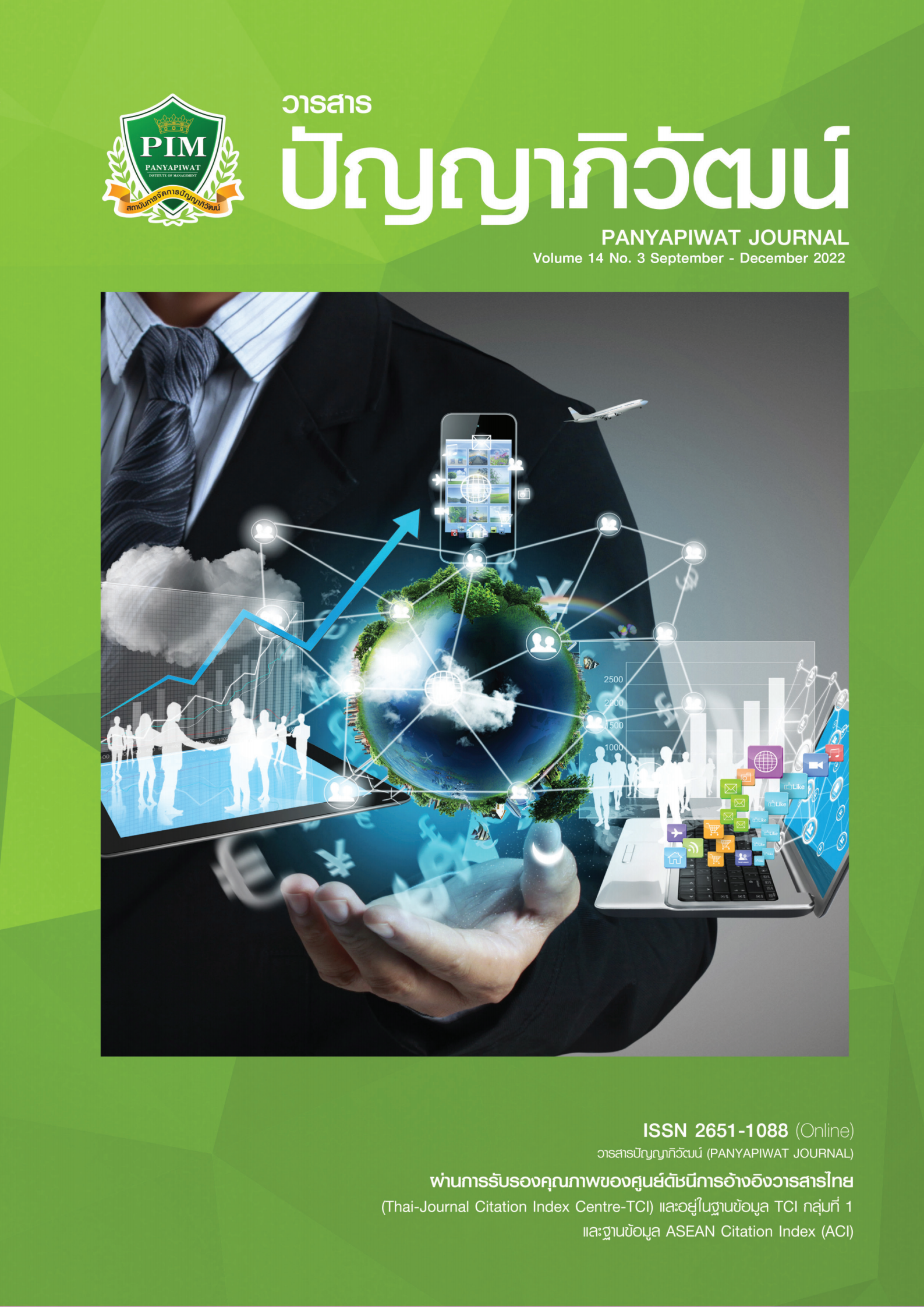ทิศทางการท่องเที่ยวเชิงอาหารเมืองหาดใหญ่เพื่อการสร้างมูลค่าเพิ่มของอาหารภายหลังวิกฤตโควิด 19
Main Article Content
บทคัดย่อ
วัตถุประสงค์ของงานวิจัยเพื่อศึกษาทิศทางการท่องเที่ยวเชิงอาหารเมืองหาดใหญ่เพื่อการสร้างมูลค่าเพิ่มของอาหารภายหลังวิกฤตโควิด 19 ประชากร ได้แก่ นักท่องเที่ยวชาวไทยที่เข้ามาเที่ยวถนนนิพัทธ์อุทิศ 1 อําเภอหาดใหญ่ จังหวัดสงขลา โดยไม่ทราบกลุ่มประชากรที่แน่นอน กลุ่มตัวอย่าง จํานวน 384 คน การสุ่มกลุ่มตัวอย่างโดยอาศัยความน่าจะเป็น สุ่มตัวอย่างแบบง่าย ค่าดัชนีความสอดคล้องเชิงเนื้อหา .60-1.00 และค่าความเชื่อมั่น เท่ากับ 0.987 เครื่องมือการวิจัย คือ แบบสอบถาม การวิเคราะห์ข้อมูลเชิงปริมาณโดยใช้สถิติ ได้แก่ ค่าร้อยละ ค่าเฉลี่ย ค่าส่วนเบี่ยงเบนมาตรฐาน การทดสอบค่าที และการวิเคราะห์ความแปรปรวน วิเคราะห์ข้อมูลเชิงคุณภาพโดยการวิเคราะห์เนื้อหานํามาเขียนเป็นความเรียง
ผลการวิจัยพบว่า ทิศการท่องเที่ยวเชิงอาหารเมืองหาดใหญ่เพื่อการสร้างมูลค่าเพิ่มของอาหารภายหลังวิกฤตโควิด 19 โดยภาพรวมอยู่ในระดับมาก เมื่อพิจารณาเป็นรายด้านพบว่า ด้านการตลาดและประชาสัมพันธ์การท่องเที่ยวเชิงอาหาร ด้านการจัดการอนุรักษ์และพัฒนาทรัพยากรท่องเที่ยวอาหาร ด้านระบบสาธารณสุขในการป้องกันการระบาดโรคติดเชื้อไวรัสโคโรนา 2019 ด้านความปลอดภัยและความมั่นคง และด้านสิ่งอํานวยความสะดวก ทุกด้านอยู่ในระดับมาก และเปรียบเทียบระหว่างเพศชายและเพศหญิง แตกต่างกันอย่างมีนัยสําคัญทางสถิติที่ 0.05 ข้อเสนอแนะ ได้แก่ เกิดรูปแบบการท่องเที่ยววิถีใหม่ มีการส่งเสริมการท่องเที่ยวแบบวิถีใหม่ อยู่ภายใต้มาตรการการควบคุมโรคระบาดโควิด 19 และเพิ่มช่องทางในการจัดจําหน่ายอาหารให้กับผู้ประกอบการ โดยการพัฒนาระบบการตลาดแบบออนไลน์ในการประชาสัมพันธ์การท่องเที่ยวเชิงอาหาร การจําหน่ายอาหาร และสินค้าต่าง ๆ สร้างรายได้ให้กับผู้ประกอบการในพื้นที่ที่ได้รับผลกระทบจากการระบาดของโรคโควิด 19 ได้อีกช่องทางหนึ่งและรองรับนักท่องเที่ยวที่จะมาสัมผัสการท่องเที่ยวเชิงอาหารในอนาคต
Article Details

อนุญาตภายใต้เงื่อนไข Creative Commons Attribution-NonCommercial-NoDerivatives 4.0 International License.
“ข้าพเจ้าและผู้เขียนร่วม (ถ้ามี) ขอรับรองว่า บทความที่เสนอมานี้ยังไม่เคยได้รับการตีพิมพ์และไม่ได้อยู่ระหว่างกระบวนการพิจารณาลงตีพิมพ์ในวารสารหรือแหล่งเผยแพร่อื่นใด ข้าพเจ้าและผู้เขียนร่วมยอมรับหลักเกณฑ์การพิจารณาต้นฉบับ ทั้งยินยอมให้กองบรรณาธิการมีสิทธิ์พิจารณาและตรวจแก้ต้นฉบับได้ตามที่เห็นสมควร พร้อมนี้ขอมอบลิขสิทธิ์บทความที่ได้รับการตีพิมพ์ให้แก่สถาบันการจัดการปัญญาภิวัฒน์หากมีการฟ้องร้องเรื่องการละเมิดลิขสิทธิ์เกี่ยวกับภาพ กราฟ ข้อความส่วนใดส่วนหนึ่งและ/หรือข้อคิดเห็นที่ปรากฏในบทความข้าพเจ้าและผู้เขียนร่วมยินยอมรับผิดชอบแต่เพียงฝ่ายเดียว”
เอกสารอ้างอิง
Academic Focus. (2017). Tourism safety. Secretariat of the House of Representatives. [in Thai]
Bltbangkok. (2019). Thai tourism income 4th highest in the world. https://www.bltbangkok.com/poll/4594/ [in Thai]
Boondach, P., & Punyasiri. S. (2018). Guidelines for tourism development in Tham Le Khao Kob at Huaiyot District, Trang Province. Burapha Journal of Business Management, 7(2), 122-138. [in Thai]
Bunnoon, P., Thongtang, L., & Nuasoi, W. (2020). Behavior of Thai tourists towards creating value added of the Chue-Chang community, Hatyai District, Songkhla Province case study: During the vegetarian festival. Panyapiwat Journal, 12(2), 135-148. [in Thai]
Chamnina, E. (2020). Tourism safety management in Phuket. Journal of MCU Nakhondhat, 7(8), 174-189.
Chanin, O., Sriprasert, P., Rahman, H. A., & Don, M. S. (2015). Guidelines on Halal tourism management in the Andaman Sea Coast of Thailand. Journal of Economics, Business and Management, 3(8), 791-794.
Chunping, Z. (2015). Chinese tourists behaviour and satisfaction with their visit to Pattaya, Chon Buri Province. Faculty of Liberal Arts, North Bangkok University. [in Thai]
Cordesmeyer, M., & Papathanassis, A. (2011). Safety Perceptions in the Cruise Sector: A grounded theory approach. In P. Gibson, A. Papathanassis, & P. Milde (Eds.), Cruise industry challenges: Making progress in an uncertain world (pp. 127-146). Gabler.
Cronbach, L. J. (1990). Essentials of psychological testing (5th ed.). Harper & Row.
Department of Disease Control. (2020a). COVID-19. https://ddc.moph.go.th/viralpneumonia/index.php [in Thai]
Department of Disease Control. (2020b). Criteria to consider according to the severity of the outbreak of coronavirus disease 2019 national level. https://ddc.moph.go.th/viralpneumonia/im_commands.php [in Thai]
Khamsee, N. (2017). The influence of Perception of destination safety through social media on tourist’s decisions to travel to Chiang Mai, Thailand [Master’s thesis]. Bangkok University. [in Thai]
Google Sites. (2020). Tourism facilities. https://sites.google.com/site/fhdfh656/sing-xanwykhwam-sadwk
Hall, C. M., Sharples, L., Mitchell, R., Macionis, N., & Cambourne, B. (2003). Food tourism around the world: Development, management, and markets. Butterworth-Heinemann.
Lichfield, D. (1992). Urban Regeneration for the 1990’s. London Planning Advisory Committee.
Likert, R. (1967). The method of constructing and attitude scale, reading in attitude theory and measurement. Wiley & Son.
Limarunothai, W., & Chuntuk, T. (2016). Information system applied for increasing the service quality of condominium. Veridian E-Journal, Silpakorn University, 9(1), 341-355. [in Thai]
Mallapaty, S. (2020). What the cruise-ship outbreaks reveal about COVID-19. Nature, 580(7801), 18.
Metiyothin, S. (2013). Marketing for international tour package program business. Journal of Management Sciences, 30(2), 52-70.
Mizal, K., Fabeil, N. F., & Pazim, K. H. (2014). Financial sustainability of Community-Based Tourism (CBT): The case of tourism cooperative limited (KOPEL BERHAD). International Journal of Research in Business Management, 2(1), 23-32.
National Institute of Development Administration. (2018). Workshop cost project to formulate a strategy for building confidence in safety in the life and property of foreign tourists. National Institute of Development Administration. [in Thai]
National Institute of Development Administration. (2020). Expense project for organizing a workshop to formulate a strategy building confidence in the life and property safety of foreign tourists. National Institute of Development Administration. [in Thai]
Office of the Royal Society. (2009). Tourism resources. http://www.royin.go.th/?knowledges
Panyarot, S. (2015). Public relations for marketing. TPA News, 223, 45-46.
Pongnirundorn, S., Buatham, O., & Yodsuwan, C. (2016). Guidelines for effective development in tourism management of Wang Nam Khiao District, Nakhon Ratchasima Province. MBA-KKU Journal, 9(1), 234-259.
Ratchatahirun, P. (2015). Facility factors of homestay affecting on Thai tourists at Chiangkan Loei [Master’s thesis]. Siam University. [in Thai]
Roscoe, J. T. (1975). Fundamental research statistics for the behavioral sciences (2nd ed.). Holt, Rinehart and Winston.
Rovinelli, R. J., & Hambleton, R. K. (1976). On the use of content specialists in the assessment of criterion-referenced test item validity. In The American Educational Research (pp. 1-37). The American Educational Research Association (AERA).
Sermchayut, R. (2020). Promotion strategy for community-based tourism. Journal of ?Multidisciplinary Academic Research and Development, 2(4), 51-61. [in Thai]
Singkhalah, S. (2017). Development of sustainable tourism at Kamala Sub-district and Kathu District, Phuket in tourism operators’ and local government officers’ perspective. Journal of Humanities and Social Sciences Rajapruek University, 3(2), 127-136.
Suanpleng, P. (2016). Gastronomic tourism. Tourism Economic Review, (4), 40-44. [in Thai]
Supasorn, Y. (2020). After COVID turns crisis into opportunity chu focus on health tourism culture and food pulling high-end tourists focus on quality over quantity VOC to leverage measures to support sustainability. https://www.nxpo.or.th/th/4815/
Thongdee, N., & Boonsak, K. (2017). The community tourism marketing management based on cultural heritage site of Khong-Chi-Mun river basin for linked Thai-Laos-Vietnam tourism. Area Based Development Research Journal, 9(2), 122-137. [in Thai]
Tourism Authority of Thailand. (2020). Ecotourism from the perspective of the people in Thailand. Ministry of Tourism and Sports. [in Thai]
Wikipedia. (1999). 1997 Asian financial crisis. https://th.wikipedia.org/wiki
Worachananan, M. (2018). Gastronomy tourism. Bangkok University. [in Thai]
Yokkhun, A., Ratchaphakdee, C., & Phitchayarom, T. (2020). The approach of gastronomy tourism development for Thailand. EAU Heritage Journal, 10(1), 60-68. [in Thai]


